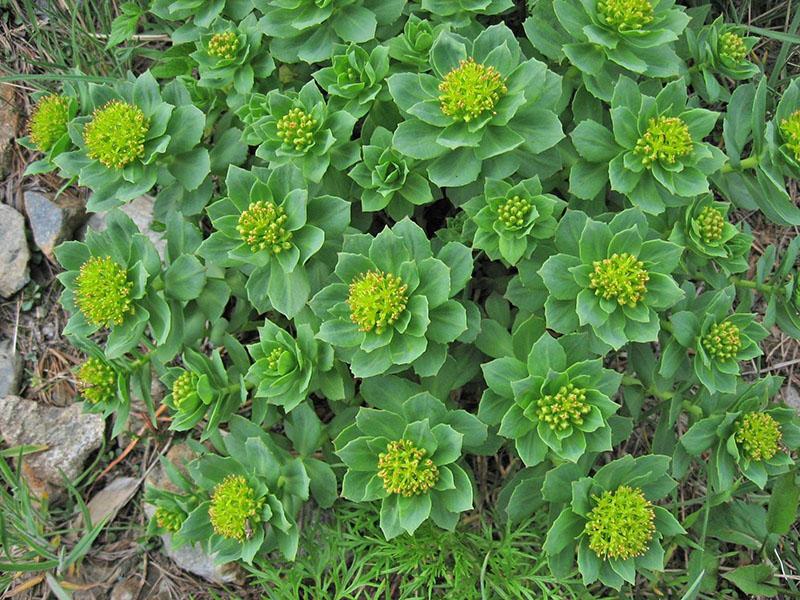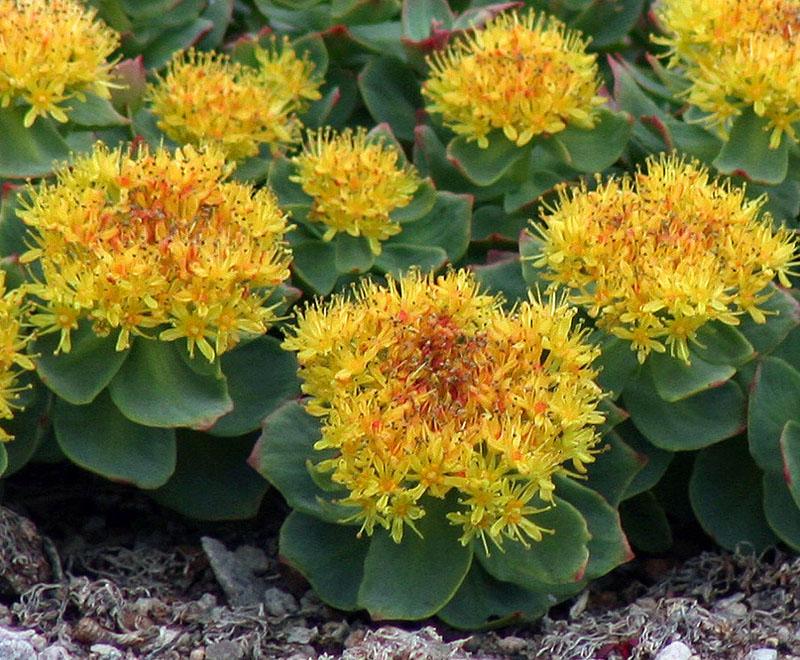Fascinating cultivation of Rhodiola rosea and care in a country flower bed
 It is not uncommon to see a plant with fleshy leaves and bright yellow flowers in the areas of pragmatic growers. This is the golden root or Rhodiola rosea, the cultivation and care of which, subject to agricultural regulations, provides the owners with valuable medicinal raw materials.
It is not uncommon to see a plant with fleshy leaves and bright yellow flowers in the areas of pragmatic growers. This is the golden root or Rhodiola rosea, the cultivation and care of which, subject to agricultural regulations, provides the owners with valuable medicinal raw materials.
Rhodiola pink in all its glory

The stem of the plant is erect, not branching, it grows up to 65 cm. On one rhizome, up to 15 stems grow. The leaf blades are very dense, fleshy, which is typical for all fatty plants, elliptical in shape with denticles and notches at the tops.
 Many people, hearing the name "Rhodiola rosea" imagine pale pink inflorescences. In fact, in nature, the plant has small yellowish flowers, collected in dense corymbose inflorescences. Rhodiola received the beautiful name for the very pleasant aroma of roses, which its roots exude when they break. Flowering lasts from late June to early July. The fruits ripen by August, reach a length of 0.6-0.8 cm, have a greenish or reddish color. Under natural conditions, the plant can be found near streams in the mountains, as it loves moisture very much in order to maintain the fleshiness of its roots and leaves.
Many people, hearing the name "Rhodiola rosea" imagine pale pink inflorescences. In fact, in nature, the plant has small yellowish flowers, collected in dense corymbose inflorescences. Rhodiola received the beautiful name for the very pleasant aroma of roses, which its roots exude when they break. Flowering lasts from late June to early July. The fruits ripen by August, reach a length of 0.6-0.8 cm, have a greenish or reddish color. Under natural conditions, the plant can be found near streams in the mountains, as it loves moisture very much in order to maintain the fleshiness of its roots and leaves.
The golden root is a plant that, because of its beneficial qualities, people thoughtlessly exterminate, collecting in huge volumes. This consumerist attitude has led to a disastrous situation. The flower has become less and less common in the wild and is listed as a rare species in the Red Book.
Fortunately, the methods for growing and caring for Rhodiola rosea are pretty simple. It can be artificially bred in almost any region, providing the unpretentious plant with the most ordinary conditions, so a beautiful flower can often be seen in flower beds and plots.
Popular varieties of rhodiola
 Currently, botanists have confirmed the existence of approximately 90 species of Rhodiola in nature.
Currently, botanists have confirmed the existence of approximately 90 species of Rhodiola in nature.
But flower growers, in addition to the golden root, most often pay special attention to the following types:
- Rhodiola Kirillova. A half-meter plant that grows in the mountains of Asia. It has a tuberous root system, pointed leaf blades. Beautiful inflorescences begin to delight the eye from mid-May.

- Rhodiola Lileynolistnaya. A small plant stretching up to 30 cm in height. It has an erect stem and leaves.

- Toothed. This variety is found most often in the mountains of Asia. Differs in a superficial tuberous root system. Leaf blades are ovoid, greenish with a bluish bloom.

Breeding methods of Rhodiola rosea
 The golden root is naturally propagated by seeds. Some gardeners also choose this method or divide the rhizome.
The golden root is naturally propagated by seeds. Some gardeners also choose this method or divide the rhizome.
Seed reproduction
 One of the popular ways Radiola rosea reproduces is by growing from seeds. When choosing this method, they begin to engage in soil preparation in winter or late autumn.
One of the popular ways Radiola rosea reproduces is by growing from seeds. When choosing this method, they begin to engage in soil preparation in winter or late autumn.
The process includes the following steps:
- Expanded clay is poured into small boxes with a layer of 5 cm, filled with loose, air-permeable soil. Disinfect with a weak solution of potassium permanganate and lightly tamp.
- Seeds are evenly scattered on the ground and slightly buried. A small amount of clean, fine river sand is poured on top so that it only covers the seeds.
- Cover the planting with polyethylene and expose it to the open air. Sprinkle with snow.
- With the onset of spring (about mid-March), the box with the plantings is transferred to a well-lit, warm place.
- In a few days, friendly shoots of young plants will appear. The film is removed.
Growing and caring for Rhodiola rosea takes patience. The shoots initially grow very sluggishly. If dense crops have sprung up, then after a week they are carefully planted. To do this, the ground under the plants is thoroughly watered, a young Rhodiola with a lump of earth is carefully poked with a match and transferred to a new planting site.
In order not to suffer with transplants, gardeners use a different method of germinating seeds. They are placed in pots on the balconies. For the winter, the pots are covered with foil, and in the spring a wire visor is installed over it, which is covered with foil. Seedlings grown in such conditions sprout faster and develop better than those grown in an apartment. After 2 months, the plants are planted in a permanent place. With proper care, some plants bloom in the first year.
Do not plant a lot of Rhodiola of the same age right away. Better to plant new flowers every year.
Division of roots
 Before you grow Rhodiola rosea yourself, you need to know that it belongs to dioecious plants, so not all of them give seed.
Before you grow Rhodiola rosea yourself, you need to know that it belongs to dioecious plants, so not all of them give seed.
In this case, gardeners prefer reproduction by dividing rhizomes.:
- To do this, choose biennial tubers weighing more than 30 g.
- They are cut into 2 equal parts and sprinkled with ash and crushed charcoal.
- Then they are planted in the soil, deepening by 1-1.5 cm.
- A liter jar of compost or humus is added to the soil, a tablespoon of potassium sulfate and superphosphate each.
- The planting material is covered with humus, leaving buds on the surface, watered and mulched with peat.
Rhodiola rosea: growing and caring for a plant in open beds
 For a permanent place in the open field, wind-protected, sandy, loose soils are suitable.
For a permanent place in the open field, wind-protected, sandy, loose soils are suitable.
Agrotechnology of Rhodiola rosea is very simple:
- The main condition for the rapid growth and development of a flower is good soil moisture. But at the same time, they provide good drainage, since in the swampy soil Rhodiola will get sick and die.
- There should be enough sunlight, but it is better for the plant to be in partial shade, since direct rays lead to sunburn on the leaves and they die off.
Before growing the golden root in the open field, prepare the site:
- For each square meter, 15 g of nitrogenous fertilizers, 20 g of superphosphate, potassium salt and 2 buckets of rotted manure or compost from humus and peat are applied.
- For acidified soil, 30 g of lime is required.
- The soil is dug onto a shovel bayonet.
- Plants are planted at least 20 cm apart, 50 cm are left between the rows.
The fertilizers introduced during the preparation of the site will actively feed the plant for 3-5 years.
Fertilization schedule
 The first feeding with diluted chicken droppings in a ratio of 1 to 20 is carried out when the plants grow to 6 cm. Additionally, 0.5 tablespoons of potassium sulfate and superphosphate are diluted in 10 liters of water and watered with rhodiola. After watering, the plants are mulched. For the entire growing season, 5 similar dressings are carried out.At the end of August, rhodiola is fed with potassium sulfate dissolved in a bucket of water and superphosphate, 1.5 tablespoons of each component. For the winter, the plants are covered with mulch with a layer of 1 cm.
The first feeding with diluted chicken droppings in a ratio of 1 to 20 is carried out when the plants grow to 6 cm. Additionally, 0.5 tablespoons of potassium sulfate and superphosphate are diluted in 10 liters of water and watered with rhodiola. After watering, the plants are mulched. For the entire growing season, 5 similar dressings are carried out.At the end of August, rhodiola is fed with potassium sulfate dissolved in a bucket of water and superphosphate, 1.5 tablespoons of each component. For the winter, the plants are covered with mulch with a layer of 1 cm.
 As for diseases and pests, Rhodiola rosea has a good immunity to diseases, from pests it is annoyed by sedum and badan weevils. The first pest damages the leaves by gnawing them. Get rid of it by shaking off the larvae with your hands on the sticky surface. Badan weevil loves to feast on rhizomes. Therefore, before planting, they are carefully examined and kept for 15 minutes in a strong solution of sodium chloride.
As for diseases and pests, Rhodiola rosea has a good immunity to diseases, from pests it is annoyed by sedum and badan weevils. The first pest damages the leaves by gnawing them. Get rid of it by shaking off the larvae with your hands on the sticky surface. Badan weevil loves to feast on rhizomes. Therefore, before planting, they are carefully examined and kept for 15 minutes in a strong solution of sodium chloride.
Rhodiola pink looks great in the country and on any site. Growing it, gardeners not only provide themselves with valuable medicinal raw materials, but also preserve this plant in the Red Book for future generations.